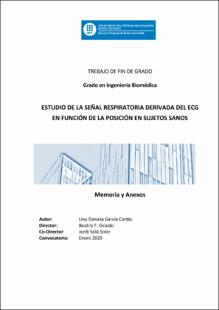Mostrar el registro sencillo del ítem
Estudio de la señal respiratoria derivada del ECG en función de la posición en sujetos sanos
| dc.contributor.advisor | Giraldo, Beatriz (dir) | spa |
| dc.contributor.author | García Cortés, Lina Daniela | spa |
| dc.date.accessioned | 2020-11-05T20:15:26Z | spa |
| dc.date.accessioned | 2021-10-01T14:29:37Z | |
| dc.date.available | 2020-11-05T20:15:26Z | spa |
| dc.date.available | 2021-10-01T14:29:37Z | |
| dc.date.issued | 2020-01 | spa |
| dc.identifier.uri | https://repositorio.escuelaing.edu.co/handle/001/1281 | |
| dc.description.abstract | Nowadays, the analysis of biomedical signals has become an important source of information in the health sector by providing relevant data on the different systems that constitute the human body. One of the most studied signals is the electric performance of the heart obtained by electrocardiography. Furthermore, these signals contain information related to the respiratory activity. The main objective of this project is to characterize the respiratory signal from the electrocardiographic signal, considering the position of the subject sitting and supine. Different algorithms have been developed to determine the characteristic parameters of the electrocardiographic signal for the identification of the QRS complex. Methods related to the area, the slopes and the angles of the complex QRS have been implemented to obtain the respiratory signal from the ECG. The signals from leads I, II, III and Chest have been analyzed and compared with the respiratory volume signal. Based on the correlation between the different signals, their similarity to the respiratory signal has been determined as a function of the position of the subject. Taking into consideration the results obtained, we observe that Chest lead presents the highest similarity to the respiratory signal for the three methods. | eng |
| dc.description.abstract | Actualmente el análisis de señales biomédicas se ha convertido en una fuente de información muy importante en el ámbito de la salud, ya que estas proporcionan datos relevantes de los diversos sistemas constituyentes del cuerpo humano. Una de las señales más estudiadas corresponde al funcionamiento eléctrico del corazón obtenida a partir de la electrocardiografía. Adicionalmente, estas señales contienen información relacionada con la actividad respiratoria. El objetivo principal de este proyecto es caracterizar la señal respiratoria a partir de la señal electrocardiográfica, considerando la posición del sujeto supino y sentado. Se han desarrollado diferentes algoritmos para determinar los parámetros característicos de la señal electrocardiográfica, para la identificación del complejo QRS. Métodos relacionados con el área, las pendientes y los ángulos del complejo QRS, han sido implementados para obtener la señal respiratoria a partir del ECG (EDR). Se han analizado las señales de derivaciones I, II, III y Chest, comparándolas con la señal de volumen respiratorio. A partir de la correlación entre las diferentes señales, se ha determinado su similitud con la señal respiratoria en función de la posición del sujeto. De acuerdo con los resultados obtenidos, se observa que la derivación Chest es la que presenta la mayor similitud con la señal respiratoria para los tres métodos. | spa |
| dc.format.mimetype | application/pdf | spa |
| dc.language.iso | spa | spa |
| dc.publisher | Escuela Colombiana de Ingeniería Julio Garavito | spa |
| dc.rights | Derechos Reservados - Escuela Colombiana de Ingeniería Julio Garavito | spa |
| dc.rights.uri | https://creativecommons.org/licenses/by-nc/4.0/ | spa |
| dc.subject | Señal respiratoria | spa |
| dc.subject | ECG | spa |
| dc.subject | Derivadas cardiacas | spa |
| dc.subject | Complejo QRS | spa |
| dc.title | Estudio de la señal respiratoria derivada del ECG en función de la posición en sujetos sanos | spa |
| dc.type | Trabajo de grado - Pregrado | spa |
| dc.type.version | info:eu-repo/semantics/publishedVersion | spa |
| oaire.accessrights | http://purl.org/coar/access_right/c_abf2 | spa |
| oaire.version | http://purl.org/coar/version/c_970fb48d4fbd8a85 | spa |
| dc.contributor.corporatename | Universidad Politécnica de Cataluña | spa |
| dc.description.degreelevel | Pregrado | spa |
| dc.description.degreename | Ingeniero(a) Biomédico(a) | spa |
| dc.publisher.program | Ingeniería Biomédica | spa |
| dc.rights.accessrights | info:eu-repo/semantics/openAccess | spa |
| dc.rights.creativecommons | Atribución-NoComercial 4.0 Internacional (CC BY-NC 4.0) | spa |
| dc.type.coar | http://purl.org/coar/resource_type/c_7a1f | spa |
| dc.type.content | Text | spa |
| dc.type.driver | info:eu-repo/semantics/bachelorThesis | spa |
| dc.type.redcol | http://purl.org/redcol/resource_type/TP | spa |
| dc.subject.keywords | Respiratory signal | spa |
| dc.subject.keywords | ECG | spa |
| dc.subject.keywords | Cardiac derivatives | spa |
| dc.subject.keywords | QRS complex | spa |
Ficheros en el ítem
Este ítem aparece en la(s) siguiente(s) colección(ones)
-
BA - Trabajos Dirigidos de Biomédica [227]
Trabajos del Pregrado de Ingeniería Biomédica de la Escuela Colombiana de Ingeniería Julio Garavito












